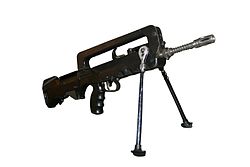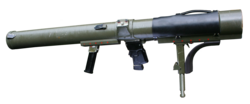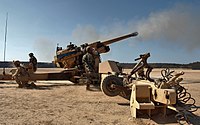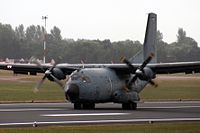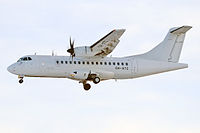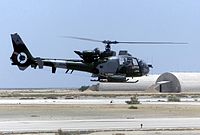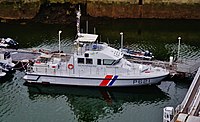Talaharan Black Guard Corps: Difference between revisions
| (18 intermediate revisions by the same user not shown) | |||
| Line 1: | Line 1: | ||
{{Infobox military unit | {{Infobox military unit | ||
| unit_name = [[Talahara| | | unit_name = [[Talahara|UCDF Black Guard Corps]] | ||
| native_name = | | native_name = ⵜⴰⴼⴻⴽⴽⴰ ⵏ ⴰⵄⴰⵙⵙⴰⵙ ⴰⴱⴻⵔⴽⴰⵏ</br>''Tafekka n Aɛessas Aberkan'' | ||
| image = BlackNode.svg | | image = BlackNode.svg | ||
| image_size = 150 | | image_size = 150 | ||
| Line 15: | Line 15: | ||
| role = {{wp|Land warfare}} | | role = {{wp|Land warfare}} | ||
| size = 119,500 | | size = 119,500 | ||
| command_structure = [[ | | command_structure = [[United Communes Defense Forces]] | ||
| garrison = | | garrison = | ||
| garrison_label = | | garrison_label = | ||
| Line 55: | Line 55: | ||
}} | }} | ||
The '''Talaharan Black Guard Corps''' ({{wp|Central Atlas Tamazight|Takelat}}: '' | The '''Talaharan Black Guard Corps''' ({{wp|Central Atlas Tamazight|Takelat}}: ''Tafekka n Aɛessas Aberkan''; ⵜⴰⴼⴻⴽⴽⴰ ⵏ ⴰⵄⴰⵙⵙⴰⵙ ⴰⴱⴻⵔⴽⴰⵏ), officially the '''United Communes Defense Forces Black Guard Corps''' and commonly referred to as the '''Black Guards''', is a community militia branch or national guard of the [[United Communes Defense Forces]]. Both the oldest and largest branch of the UCDF, the Black Guard Corps is a volunteer organization of part-time members. The Black Guard Corps's members live in their own communities and work in normal industries. However, they also dedicate a significant amount of time to training and other activities associated with the national defense of [[Talahara]]. On average, Black Guards have a greater number of training hours than reservists in most armies, though proportionally they dedicate more time to service. In addition, Black Guards are limited to territorial defense and cannot assist in offensive actions or deployments. The term "Black Guard" can be used to refer to the Black Guard Corps as a whole, regiment-sized guard units in the force, or individual members of the force, interchangeably. | ||
Unlike the rest of the | Unlike the rest of the UCDF, the size of the Black Guard Corps is not limited by statute. As of 2022, the total number of Black Guards is 119,500. This equates to an average of 95 service members per commune, though the distribution of Black Guard units is not consistent across the country. Many of these members are not standard militia members of the Black Guard Corps, but rather perform administrative functions for the branch or other service branches of the UCDF. The typical commune is thus able to support two platoons of combat-ready Black Guards. | ||
While small units of the Black Guard Corps maintain the typical Talaharan advancement system based on elections and seniority, the appointment of officers differs. Rather than qualified candidates being put forward for election, Communal Legislative Councils appoint officers subject to ratification by the entire commune. Units that span multiple communes are subject to coordination between Communal Councils. At the Defense Committee, the Black Guard Corps has two seats as with any other branch. The senior representative is District Colonel Akzi 'Albun. The enlisted representative is Sergeant Amastan Tsahana. | While small units of the Black Guard Corps maintain the typical Talaharan advancement system based on elections and seniority, the appointment of officers differs. Rather than qualified candidates being put forward for election, Communal Legislative Councils appoint officers subject to ratification by the entire commune. Units that span multiple communes are subject to coordination between Communal Councils. At the Defense Committee, the Black Guard Corps has two seats as with any other branch. The senior representative is District Colonel Akzi 'Albun. The enlisted representative is Sergeant Amastan Tsahana. | ||
| Line 64: | Line 64: | ||
===Origin=== | ===Origin=== | ||
The Black Guards emerged in the early period of the [[Talaharan Civil War]] as peoples' militias opposed to both the Third Talaharan Kingdom and the competing Liberal Republic of Talahara. The organization of different Black Guard units varied greatly, but in general the militias were radically democratic units who accepted combatants from all walks of life. The name of the forces came from the black banners and armbands the members used to identify with the people's cause. The first Black Guard movements carved out independent communities, some forming alliances with neighbouring communities. With the arrival of Ziri Akli, a revolutionary scholar and organizer in February 1836, the Commune Council was founded as a central coordinating body for the various Black Guard units. | The Black Guards emerged in the early period of the [[Talaharan Civil War]] as peoples' militias opposed to both the Third Talaharan Kingdom and the competing Liberal Republic of Talahara. The organization of different Black Guard units varied greatly, but in general the militias were radically democratic units who accepted combatants from all walks of life. The name of the forces came from the black banners and armbands the members used to identify with the people's cause. The first Black Guard movements carved out independent communities, some forming alliances with neighbouring communities. With the arrival of Ziri Akli, a revolutionary scholar and organizer in February 1836, the Commune Council was founded as a central coordinating body for the various Black Guard units. | ||
===Modern form=== | ===Modern form=== | ||
[[File:Le défilé de la libération - Tunis.jpg|210px|thumb|right|Black Guards practice marching in Weskera, c. 1940]] | [[File:Le défilé de la libération - Tunis.jpg|210px|thumb|right|Black Guards practice marching in Weskera, c. 1940]] | ||
In the years following the Civil War, the Black Guards were largely demobilized to their home communities. Despite demobilization for most units, the retained cohesion, training, and supplies made them a major stabilizing factor and successfully dissuaded foreign invasions and opposition to the revolutionary state. Many other units remained engaged in hunting down remnant monarchist and capitalist warbands. At the same time, the Black Guards struggled to remobilize into a large-scale offensive force. Plans to | In the years following the Civil War, the Black Guards were largely demobilized to their home communities. Despite demobilization for most units, the retained cohesion, training, and supplies made them a major stabilizing factor and successfully dissuaded foreign invasions and opposition to the revolutionary state. Many other units remained engaged in hunting down remnant monarchist and capitalist warbands. At the same time, the Black Guards struggled to remobilize into a large-scale offensive force. Plans to Taršiš from the Yisraeli-backed government never came to fruition. | ||
In order to supplement the land power of the Black Guards and protect the Talaharan stretch of the Rubric Coast, the Talaharan Navy was founded in 1845. The Black Guards's irregular nature and niche of territorial defense was further enshrined in 1854 with the formation of the [[Talaharan Army Corps]], one year after the Talaharan Navy and the Black Guards were renamed to the Navy Corps and Black Guard Corps, respectively. | In order to supplement the land power of the Black Guards and protect the Talaharan stretch of the Rubric Coast, the Talaharan Navy was founded in 1845. The Black Guards's irregular nature and niche of territorial defense was further enshrined in 1854 with the formation of the [[Talaharan Army Corps]], one year after the Talaharan Navy and the Black Guards were renamed to the Navy Corps and Black Guard Corps, respectively. | ||
Over the course of the next century, the Black Guards remained an important civic and military fixture in a defensive capacity. However, the Black Guard Corps was not mobilized for either the Annexation of Amara, nor the Liberation of | Over the course of the next century, the Black Guards remained an important civic and military fixture in a defensive capacity. However, the Black Guard Corps was not mobilized for either the Annexation of Amara, nor the Liberation of Taršiš. During the [[Social War]], a number of Talaharan Black Guards were likely among Tyreseian volunteers who travelled to Latium to assist the Latin Social Republic. The effort ultimately failed and the Social Republic fell in 1947. As offensive participation fell beyond the mandate of the branch, any evidence of Black Guard activity in the war effort was suppressed, though culturally some fighters were seen as martyrs for international socialism. | ||
In the present day, Black Guards have less cultural capital but remain an important component of the | In the present day, Black Guards have less cultural capital but remain an important component of the UCDF. Many administrative and auxiliary tasks in the unified armed forces are fufilled by semi-civilian specialists who operate through the Black Guards. Furthermore, the Black Guard Corps is relied upon for national defense plans and a significant amount of personnel and equipment. | ||
==Structure and organization== | ==Structure and organization== | ||
The structure of the Black Guard Corps differs significantly from that of the Army Corps, adhering more closely to the legislative structure of the United Communes of Talahara than to a military organization. Each commune raises a company of Black Guards. The size of a company can vary between two and four platoons. Auxiliary staff such as medical professionals and administrators are siloed off into auxiliary companies. At present, there are 1,250 communes in Talahara and thus there are 1,250 Black Guard companies of varying strengths. | |||
The structure of the Black Guard Corps differs significantly from that of the Army Corps, adhering more closely to the legislative structure of the United Communes of Talahara than to military organization. Each commune raises a company of Black Guards. The size of a company can vary between two and four platoons. Auxiliary staff such as medical professionals and administrators are siloed off into auxiliary companies. At present, there are 1,250 communes in Talahara and thus there are 1,250 Black Guard companies of varying strengths. | |||
Groups of 25 companies are made into "black guards", regiment-equivalent units which are organized at the Regional Council | Groups of 25 companies are made into "black guards", regiment-equivalent units which are organized at the Regional Council level. Each black guard is subdivided into five battalions, each with five companies. Black guards generally count between 2,300 and 2,500 troops. One of the five battalions in a black guard is a tank battalion, another is an artillery battalion, and the remainin three are infantry battalions. Mechanization is uncommon and the bulk of the Black Guard forces are light infantry. | ||
The auxiliary forces of the Black Guard Corps are also organized into auxiliary guard units at the | The auxiliary forces of the Black Guard Corps are also organized into auxiliary guard units at the Regional Council level. An auxiliary guard may be an auxiliary administrative guard or an auxiliary medical guard unit. These units may be seconded on a long or short-term basis to the administrative or medical divisions of other branches of the UCDF. | ||
The core of the Black Guard Corps's military doctrine is area defense, primarily in defense-in-depth. While Black Guard companies are raised in local communities, black guard units are frequently deployed around the country for exercises and | The core of the Black Guard Corps's military doctrine is area defense, primarily in defense-in-depth. While Black Guard companies are raised in local communities, black guard units are frequently deployed around the country for exercises and preparing for multi-stage defense plans. In case of invasion, the Black Guard Corps can activate and mobilize units from across the country. Different defense plans exist for a number of scenarios, including land, sea, and air invasions from each cardinal direction, or multiple invasions at once. | ||
The most common strategic unit in battle organization is the battalion. | The most common strategic unit in battle organization is the battalion. Entire black guard units are occasionally grouped together for large-scale manoeuvres, particularly groups of tank battalions taken from a cross-section of black guards in a district. However, due to an emphasis on static defense, maintaining extended fronts, and unit cohesion for comparatively untrained groups, units smaller than a battalion are rarely directly accounted for in battle plans. | ||
==Equipment== | ==Equipment== | ||
| Line 168: | Line 98: | ||
!colspan=2|Notes | !colspan=2|Notes | ||
|- | |- | ||
|{{wp|SPECTRA helmet| | |{{wp|SPECTRA helmet|S101}} | ||
| style="background:white;"|[[File:Casque-spectra-2.JPG|center|150px]] | | style="background:white;"|[[File:Casque-spectra-2.JPG|center|150px]] | ||
|[[File:Rubric Coast Partnership Flag.png|23px]] [[Rubric Coast Consortium|Rubric Coast]] | |[[File:Rubric Coast Partnership Flag.png|23px]] [[Rubric Coast Consortium|Rubric Coast]] | ||
| Line 174: | Line 104: | ||
|colspan=2|Constructed from proprietary polyethylene fibres, protects against fragmentation and pistol-calibre bullets | |colspan=2|Constructed from proprietary polyethylene fibres, protects against fragmentation and pistol-calibre bullets | ||
|- | |- | ||
|{{nowrap|{{wp|M40 Field Protective Mask| | |{{nowrap|{{wp|M40 Field Protective Mask|OX-TG99}}}} | ||
| style="background:white;"|[[File:2007 NCO and Soldier of the Year Competition - Warrior Tasks Testing DVIDS54681.jpg|center|150px]] | | style="background:white;"|[[File:2007 NCO and Soldier of the Year Competition - Warrior Tasks Testing DVIDS54681.jpg|center|150px]] | ||
|{{flag|Ostrozava}} | |{{flag|Ostrozava}} | ||
|{{wp|Gas mask}} | |{{wp|Gas mask}} | ||
|colspan=2|Includes a voicemitter, a drinking system, and ambidextrous filter mounting, filters up to 17 different agents | |colspan=2|Includes a voicemitter, a drinking system, and ambidextrous filter mounting, filters up to 17 different agents | ||
|- | |||
|{{nowrap|{{wp|Camouflage Daguet|QK98}}}} | |||
| style="background:white;"|[[File:Daguet pattern.svg|center|120px]] | |||
|{{flag|Talahara}} | |||
|{{wp|Military camouflage}} | |||
|colspan=2|Three-tone desert pattern | |||
|- | |- | ||
!colspan=6|<big>Small arms</big> | !colspan=6|<big>Small arms</big> | ||
| Line 189: | Line 125: | ||
!Notes | !Notes | ||
|- | |- | ||
|{{wp|FAMAS| | |{{wp|FAMAS|M87A2}} | ||
| style="background:white;"|[[File: | | style="background:white;"|[[File:FAMAS-img 1016.jpg|center|250px]] | ||
|[[File:Rubric Coast Partnership Flag.png|23px]] [[Rubric Coast Consortium|Rubric Coast]] | |{{nowrap|[[File:Rubric Coast Partnership Flag.png|23px]] [[Rubric Coast Consortium|Rubric Coast]]}} | ||
|{{wp|Assault rifle}} | |{{wp|Assault rifle}} | ||
|{{wp|.300 AAC Blackout|7.5×35mm}} | |{{wp|.300 AAC Blackout|7.5×35mm}} | ||
|Standard service rifle | |Standard service rifle | ||
|- | |- | ||
|[[RAL# | |[[RAL#M12.2FM62|M71A2]] | ||
| style="background:white;"|[[File:Mas62.png|center|250px]] | | style="background:white;"|[[File:Mas62.png|center|250px]] | ||
|[[File:Rubric Coast Partnership Flag.png|23px]] [[Rubric Coast Consortium|Rubric Coast]] | |[[File:Rubric Coast Partnership Flag.png|23px]] [[Rubric Coast Consortium|Rubric Coast]] | ||
| Line 203: | Line 139: | ||
|Rear echelon rifle and DMR | |Rear echelon rifle and DMR | ||
|- | |- | ||
|{{wp|MAS-49 rifle| | |{{wp|MAS-49 rifle|M53/63A4}} | ||
| style="background:white;"|[[File:MAS 49 56.JPG|center|250px]] | | style="background:white;"|[[File:MAS 49 56.JPG|center|250px]] | ||
|[[File:Rubric Coast Partnership Flag.png|23px]] [[Rubric Coast Consortium|Rubric Coast]] | |[[File:Rubric Coast Partnership Flag.png|23px]] [[Rubric Coast Consortium|Rubric Coast]] | ||
| Line 210: | Line 146: | ||
|Former service rifle, DMR | |Former service rifle, DMR | ||
|- | |- | ||
|{{wp|MAC 50| | |{{wp|Caracal_pistol|B115}} | ||
| style="background:white;"|[[File:Caracal F.JPG|center|90px]] | |||
|[[File:Rubric Coast Partnership Flag.png|23px]] [[Rubric Coast Consortium|Rubric Coast]] | |||
|{{wp|Pistol}} | |||
|{{wp|9×25mm Dillon|9×25mm}}</br>{{wp|10mm Auto|10×25mm}} | |||
|Standard service pistol | |||
|- | |||
|{{wp|MAC 50|B59}} | |||
| style="background:white;"|[[File:MAC-50 detoured.jpg|center|120px]] | | style="background:white;"|[[File:MAC-50 detoured.jpg|center|120px]] | ||
|[[File:Rubric Coast Partnership Flag.png|23px]] [[Rubric Coast Consortium|Rubric Coast]] | |[[File:Rubric Coast Partnership Flag.png|23px]] [[Rubric Coast Consortium|Rubric Coast]] | ||
| Line 217: | Line 160: | ||
|Standard service pistol | |Standard service pistol | ||
|- | |- | ||
|{{wp|AA-52| | |{{wp|AA-52|MZ61A3}} | ||
| style="background:white;"|[[File: | | style="background:white;"|[[File:AA52.png|center|250px]] | ||
|[[File:Rubric Coast Partnership Flag.png|23px]] [[Rubric Coast Consortium|Rubric Coast]] | |[[File:Rubric Coast Partnership Flag.png|23px]] [[Rubric Coast Consortium|Rubric Coast]] | ||
|{{wp|Medium machine gun}} | |{{wp|Medium machine gun}} | ||
|{{wp|7.5×54mm}} | |{{wp|7.5×54mm}} | ||
|Section support weapon | |Section support and vehicle-mounted weapon | ||
|- | |- | ||
|{{wp| | |{{wp|MAC-58|MZ61/67A2}} | ||
| style="background:white;"|[[File: | | style="background:white;"|[[File:MAC58.jpg|center|200px]] | ||
|[[File:Rubric Coast Partnership Flag.png|23px]] [[Rubric Coast Consortium|Rubric Coast]] | |[[File:Rubric Coast Partnership Flag.png|23px]] [[Rubric Coast Consortium|Rubric Coast]] | ||
|{{wp| | |{{wp|Heavy machine gun}} | ||
|{{wp| | |{{wp|13.2×99mm Hotchkiss|13.5×99mm}} | ||
| | |Vehicle-mounted weapon | ||
|- | |- | ||
!colspan=6|<big>Personnel ordnance</big> | !colspan=6|<big>Personnel ordnance</big> | ||
| Line 239: | Line 182: | ||
!colspan=2|Notes | !colspan=2|Notes | ||
|- | |- | ||
|{{wp|Lance-grenade individuel Mle F1 (LGI Mle F1)| | |{{wp|Lance-grenade individuel Mle F1 (LGI Mle F1)|ABG99}} | ||
| style="background:white;"|[[File:LGI entrainement.jpg|center|100px]] | | style="background:white;"|[[File:LGI entrainement.jpg|center|100px]] | ||
|[[File:Rubric Coast Partnership Flag.png|23px]] [[Rubric Coast Consortium|Rubric Coast]] | |[[File:Rubric Coast Partnership Flag.png|23px]] [[Rubric Coast Consortium|Rubric Coast]] | ||
|{{wp|Infantry mortar}} | |{{wp|Infantry mortar}} | ||
|colspan=2| Fires | |colspan=2| Fires 50mm high explosive or smoke grenades and flares | ||
|- | |- | ||
|{{wp| | |{{wp|LRAC F1|YRG87}} | ||
| style="background:white;"|[[File: | | style="background:white;"|[[File:LRAC F1-detoured-cropped.png|center|250px]] | ||
|[[File:Rubric Coast Partnership Flag.png|23px]] [[Rubric Coast Consortium|Rubric Coast]] | |||
|{{wp|Rocket-propelled grenade}} | |{{wp|Rocket-propelled grenade}} | ||
|colspan=2|Fires | |colspan=2|Fires 90mm HEAT or fragmentation grenades | ||
|- | |- | ||
|{{wp|Eryx (missile)| | |{{wp|Eryx (missile)|YLG103}} | ||
| style="background:white;"|[[File:ERYX-2ndFrInReg.jpg|center|200px]] | | style="background:white;"|[[File:ERYX-2ndFrInReg.jpg|center|200px]] | ||
|[[File:Rubric Coast Partnership Flag.png|23px]] [[Rubric Coast Consortium|Rubric Coast]] | |[[File:Rubric Coast Partnership Flag.png|23px]] [[Rubric Coast Consortium|Rubric Coast]] | ||
| Line 275: | Line 212: | ||
!Quantity | !Quantity | ||
|- | |- | ||
|{{wp|AMX-32| | |{{wp|AMX-32|T68/74A4 Serval}} | ||
| style="background:white;"|[[File:AMX-32 img 2369.jpg|center|250px]] | | style="background:white;"|[[File:AMX-32 img 2369.jpg|center|250px]] | ||
|[[File:Rubric Coast Partnership Flag.png|23px]] [[Rubric Coast Consortium|Rubric Coast]] | |[[File:Rubric Coast Partnership Flag.png|23px]] [[Rubric Coast Consortium|Rubric Coast]] | ||
| Line 293: | Line 230: | ||
!Quantity | !Quantity | ||
|- | |- | ||
|{{nowrap|{{wp|Véhicule de l'Avant Blindé| | |{{nowrap|{{wp|Véhicule de l'Avant Blindé|A85A2 Genet}}}} | ||
| style="background:white;"|[[File:French VAB APC during Operation Desert Shield.JPEG|center|250px]] | | style="background:white;"|[[File:French VAB APC during Operation Desert Shield.JPEG|center|250px]] | ||
|[[File:Rubric Coast Partnership Flag.png|23px]] [[Rubric Coast Consortium|Rubric Coast]] | |[[File:Rubric Coast Partnership Flag.png|23px]] [[Rubric Coast Consortium|Rubric Coast]] | ||
| Line 308: | Line 245: | ||
!Quantity | !Quantity | ||
|- | |- | ||
|{{wp|Véhicule Blindé Léger| | |{{wp|Véhicule Blindé Léger|RA94 Jackal}} | ||
| style="background:white;"|[[File:Interpolitex 2013 (534-29) (cropped).jpg|center|250px]] | | style="background:white;"|[[File:Interpolitex 2013 (534-29) (cropped).jpg|center|250px]] | ||
|[[File:Rubric Coast Partnership Flag.png|23px]] [[Rubric Coast Consortium|Rubric Coast]] | |[[File:Rubric Coast Partnership Flag.png|23px]] [[Rubric Coast Consortium|Rubric Coast]] | ||
| Line 328: | Line 265: | ||
!Quantity | !Quantity | ||
|- | |- | ||
|{{wp|TRF1| | |{{wp|TRF1|K99}} | ||
| style="background:white;"|[[File:F-1-Towed-Gun-howitzer.jpg|center|200px]] | | style="background:white;"|[[File:F-1-Towed-Gun-howitzer.jpg|center|200px]] | ||
|[[File:Rubric Coast Partnership Flag.png|23px]] [[Rubric Coast Consortium|Rubric Coast]] | |[[File:Rubric Coast Partnership Flag.png|23px]] [[Rubric Coast Consortium|Rubric Coast]] | ||
|{{wp|Howitzer}} | |{{wp|Howitzer}} | ||
|155mm | |155mm | ||
| | |116 | ||
|- | |- | ||
|{{wp|RT F1| | |{{wp|Obusier de 155 mm Modèle 50|K61}} | ||
| style="background:white;"|[[File:M-1950-beyt-hatotchan-2.jpg|center|200px]] | |||
|[[File:Rubric Coast Partnership Flag.png|23px]] [[Rubric Coast Consortium|Rubric Coast]] | |||
|{{wp|Howitzer}} | |||
|155mm | |||
|180 | |||
|- | |||
|{{wp|RT F1|ABG70}} | |||
| style="background:white;"|[[File:French MO-120-RT-61 and Véhicule de Tracte Mortier 120 during Operation Desert Shield.JPEG|center|200px]] | | style="background:white;"|[[File:French MO-120-RT-61 and Véhicule de Tracte Mortier 120 during Operation Desert Shield.JPEG|center|200px]] | ||
|[[File:Rubric Coast Partnership Flag.png|23px]] [[Rubric Coast Consortium|Rubric Coast]] | |[[File:Rubric Coast Partnership Flag.png|23px]] [[Rubric Coast Consortium|Rubric Coast]] | ||
| Line 342: | Line 286: | ||
|266 | |266 | ||
|- | |- | ||
|{{wp|LLR 81mm| | |{{wp|LLR 81mm|ABG106}} | ||
| style="background:white;"|[[File:Mortier 81 LLR 01.jpg|center|150px]] | | style="background:white;"|[[File:Mortier 81 LLR 01.jpg|center|150px]] | ||
|[[File:Rubric Coast Partnership Flag.png|23px]] [[Rubric Coast Consortium|Rubric Coast]] | |[[File:Rubric Coast Partnership Flag.png|23px]] [[Rubric Coast Consortium|Rubric Coast]] | ||
| Line 362: | Line 306: | ||
!colspan=6|<big>Fixed-wing aircraft</big> | !colspan=6|<big>Fixed-wing aircraft</big> | ||
|- | |- | ||
|{{wp|Transall C-160| | |{{wp|Transall C-160|{{nowrap|TMT72 Griffon Vulture}}}} | ||
|[[File:Transall (5089484505).jpg|200px|center]] | |[[File:Transall (5089484505).jpg|200px|center]] | ||
|{{flag| | |{{flag|Tsurushima}} | ||
|{{wp|Military transport aircraft|Transport aircraft}} | |{{wp|Military transport aircraft|Transport aircraft}} | ||
|2 | |2 | ||
|Cargo capacity of 16 tonnes, transport capacity of 93 infantry, 88 paratroopers, or 62 stretchers | |Cargo capacity of 16 tonnes, transport capacity of 93 infantry, 88 paratroopers, or 62 stretchers | ||
|- | |- | ||
|{{wp|ATR 42| | |{{wp|ATR 42|MT97 Heron}} | ||
|[[File:Flybe Nordic, OH-ATC, ATR 42-500 (16454798771).jpg|200px|center]] | |[[File:Flybe Nordic, OH-ATC, ATR 42-500 (16454798771).jpg|200px|center]] | ||
|{{flag|Talahara}} | |{{flag|Talahara}} | ||
| Line 378: | Line 322: | ||
!colspan=6|<big>Rotary-wing aircraft</big> | !colspan=6|<big>Rotary-wing aircraft</big> | ||
|- | |- | ||
|{{wp|SA 330 Puma| | |{{wp|SA 330 Puma|MI74 Leopard}} | ||
|[[File:XW237 Puma Helicopter (24897093826).jpg|200px|center]] | |[[File:XW237 Puma Helicopter (24897093826).jpg|200px|center]] | ||
|{{nowrap|[[File:Rubric Coast Partnership Flag.png|23px]] [[Rubric Coast Consortium|Rubric Coast]]}} | |{{nowrap|[[File:Rubric Coast Partnership Flag.png|23px]] [[Rubric Coast Consortium|Rubric Coast]]}} | ||
| Line 384: | Line 328: | ||
|3 | |3 | ||
|Can transport up to 16 passengers or 10 stretchers, can be equipped with a door-mounted 20mm autocannon and two 7.5mm machine guns | |Can transport up to 16 passengers or 10 stretchers, can be equipped with a door-mounted 20mm autocannon and two 7.5mm machine guns | ||
|- | |||
|{{wp|Aérospatiale Gazelle|MF76 Sandpiper}} | |||
|[[File:Aerospatiale Gazelle AH1 Royal Marines in Iraq 2002.JPEG|200px|center]] | |||
|{{nowrap|[[File:Rubric Coast Partnership Flag.png|23px]] [[Rubric Coast Consortium|Rubric Coast]]}} | |||
|{{wp|Utility helicopter|Light helicopter}} | |||
|18 | |||
|Can transport up to five passengers, can be equipped with two forward-facing 7.5mm machine guns or two missile/rocket pods | |||
|} | |} | ||
| Line 421: | Line 372: | ||
|'''Insignia'''|| [[File:Messidor OF-6.png|75px]] || [[File:Messidor OF-5.png|75px]] || [[File:Messidor OF-4.png|75px]] || [[File:Messidor OF-3.png|75px]] || [[File:Messidor OF-2.png|75px]] || [[File:Messidor OF-1.png|75px]] | |'''Insignia'''|| [[File:Messidor OF-6.png|75px]] || [[File:Messidor OF-5.png|75px]] || [[File:Messidor OF-4.png|75px]] || [[File:Messidor OF-3.png|75px]] || [[File:Messidor OF-2.png|75px]] || [[File:Messidor OF-1.png|75px]] | ||
|- style="text-align:center;" | |- style="text-align:center;" | ||
|'''{{wp|Central Atlas Tamazight|Takelat}} name'''|| ⴰⵇⵍⴰⵍ</br> | |'''{{wp|Central Atlas Tamazight|Takelat}} name'''|| ⴰⵇⵍⴰⵍ ⵏ</br>ⵜⴰⵖⵉⵡⴰⵏⵜ || ⴰⵇⵍⴰⵍ ⵏ</br>ⴰⵄⴰⵙⵙⴰⵙ || ⴰⵇⵍⴰⵍ ⴰⵏⵎazⴰⵍ || ⵜⴰⴱⴰⵟ || ⴰⵇⴻⴱⵟ || ⴰⵎⴹⵉⵇ | ||
|- style="text-align:center;" | |- style="text-align:center;" | ||
|'''Transliteration'''|| '' | |'''Transliteration'''|| ''Aqlal n</br>Taɣiwant'' || ''Aqlal n</br>Aɛessas'' || ''Aqlal Anmazul'' || ''Tabaṭ'' || ''Aqebṭ'' || ''Amḍiq'' | ||
|- style="text-align:center;" | |- style="text-align:center;" | ||
|'''Translation'''|| District</br>Colonel || Guard | |'''Translation'''|| District</br>Colonel || Guard-Colonel || Vice-Colonel || Major || Captain || Lieutenant | ||
|} | |} | ||
| Line 435: | Line 386: | ||
|'''Insignia'''|| [[File:Messidor OR-8.png|75px]] || [[File:Messidor OR-7.png|75px]] || [[File:Messidor OR-6.png|75px]] || [[File:Messidor OR-4.png|75px]] || [[File:Messidor OR-3.png|75px]] || [[File:Messidor OR-2.png|75px]] || [[File:Messidor OR-1.png|75px]] | |'''Insignia'''|| [[File:Messidor OR-8.png|75px]] || [[File:Messidor OR-7.png|75px]] || [[File:Messidor OR-6.png|75px]] || [[File:Messidor OR-4.png|75px]] || [[File:Messidor OR-3.png|75px]] || [[File:Messidor OR-2.png|75px]] || [[File:Messidor OR-1.png|75px]] | ||
|- style="text-align:center;" | |- style="text-align:center;" | ||
|'''{{wp|Central Atlas Tamazight|Takelat}} name'''|| | |'''{{wp|Central Atlas Tamazight|Takelat}} name'''|| ⴰⵇⴻⵔⵔⵓⵎⴻⵏⵣⴰⴷ</br>ⵏ ⵜⴰⴱⴰⵟⵢⵓⵏⵜ || ⴰⵇⴻⵔⵔⵓⵎⴻⵏⵣⴰⴷ</br>ⵏ ⵜⴰⴽⴻⴱⴱⴰⵏⵉⵜ || ⴰⵇⴻⵔⵔⵓⵎⴻⵏⵣⴰⴷ</br>ⵏ ⵜⴰⴳⵔⴰⵡⵜ || ⴰⵇⴻⵔⵔⵓ || ⴰⵎⵃⴰⴷⴷⵉⴽⵔⴰⴷ || ⴰⵎⵃⴰⴷⴷⵉⵙⵉⵏ || ⴰⵎⵃⴰⴷⴷⵉⵢⴰⵏ | ||
|- style="text-align:center;" | |- style="text-align:center;" | ||
|'''Transliteration'''|| '' | |'''Transliteration'''|| ''Aqerrumenzad</br>n Tabaṭyunt'' || ''Aqerrumenzad</br>n Takebbanit'' || ''Aqerrumenzad</br>n Tagrawt'' || ''Aqerru'' || ''Amḥaddikrad'' || ''Amḥaddisin'' || ''Amḥaddiyan'' | ||
|- style="text-align:center;" | |- style="text-align:center;" | ||
|'''Translation'''|| Battalion</br>Sergeant-Major || Company</br>Sergeant-Major || Platoon</br>Sergeant-Major || Sergeant || Guard III || Guard II || Guard I | |'''Translation'''|| Battalion</br>Sergeant-Major || Company</br>Sergeant-Major || Platoon</br>Sergeant-Major || Sergeant || Guard III || Guard II || Guard I | ||
| Line 443: | Line 394: | ||
==See also== | ==See also== | ||
*[[ | *[[United Communes Defense Forces]] | ||
*[[Talaharan | *[[Talaharan Army Corps]] | ||
*[[Talaharan | *[[Talaharan Air Corps]] | ||
*[[Talaharan | *[[Talaharan Navy Corps]] | ||
[[Category:Ajax]] | [[Category:Ajax]] | ||
[[Category:Militaries (Ajax)]] | [[Category:Militaries (Ajax)]] | ||
[[Category:Talahara]] | [[Category:Talahara]] | ||
Latest revision as of 21:35, 10 August 2024
| UCDF Black Guard Corps | |
|---|---|
| ⵜⴰⴼⴻⴽⴽⴰ ⵏ ⴰⵄⴰⵙⵙⴰⵙ ⴰⴱⴻⵔⴽⴰⵏ Tafekka n Aɛessas Aberkan | |
Roundel of the Talaharan Black Guard Corps | |
| Active | Since 1836 |
| Country | |
| Type | Militia |
| Role | Land warfare |
| Size | 119,500 |
| Part of | United Communes Defense Forces |
| Colour | Black |
| Engagements | List |
| Commanders | |
| Commander-in-Chief | Executive Council |
| Executor of Defense | Taos Jebar |
| Defense Committee Senior Representative | District Colonel Akzi 'Albun |
| Defense Committee Enlisted Representative | Sergeant Amastan Tsahana |
The Talaharan Black Guard Corps (Takelat: Tafekka n Aɛessas Aberkan; ⵜⴰⴼⴻⴽⴽⴰ ⵏ ⴰⵄⴰⵙⵙⴰⵙ ⴰⴱⴻⵔⴽⴰⵏ), officially the United Communes Defense Forces Black Guard Corps and commonly referred to as the Black Guards, is a community militia branch or national guard of the United Communes Defense Forces. Both the oldest and largest branch of the UCDF, the Black Guard Corps is a volunteer organization of part-time members. The Black Guard Corps's members live in their own communities and work in normal industries. However, they also dedicate a significant amount of time to training and other activities associated with the national defense of Talahara. On average, Black Guards have a greater number of training hours than reservists in most armies, though proportionally they dedicate more time to service. In addition, Black Guards are limited to territorial defense and cannot assist in offensive actions or deployments. The term "Black Guard" can be used to refer to the Black Guard Corps as a whole, regiment-sized guard units in the force, or individual members of the force, interchangeably.
Unlike the rest of the UCDF, the size of the Black Guard Corps is not limited by statute. As of 2022, the total number of Black Guards is 119,500. This equates to an average of 95 service members per commune, though the distribution of Black Guard units is not consistent across the country. Many of these members are not standard militia members of the Black Guard Corps, but rather perform administrative functions for the branch or other service branches of the UCDF. The typical commune is thus able to support two platoons of combat-ready Black Guards.
While small units of the Black Guard Corps maintain the typical Talaharan advancement system based on elections and seniority, the appointment of officers differs. Rather than qualified candidates being put forward for election, Communal Legislative Councils appoint officers subject to ratification by the entire commune. Units that span multiple communes are subject to coordination between Communal Councils. At the Defense Committee, the Black Guard Corps has two seats as with any other branch. The senior representative is District Colonel Akzi 'Albun. The enlisted representative is Sergeant Amastan Tsahana.
History
Origin
The Black Guards emerged in the early period of the Talaharan Civil War as peoples' militias opposed to both the Third Talaharan Kingdom and the competing Liberal Republic of Talahara. The organization of different Black Guard units varied greatly, but in general the militias were radically democratic units who accepted combatants from all walks of life. The name of the forces came from the black banners and armbands the members used to identify with the people's cause. The first Black Guard movements carved out independent communities, some forming alliances with neighbouring communities. With the arrival of Ziri Akli, a revolutionary scholar and organizer in February 1836, the Commune Council was founded as a central coordinating body for the various Black Guard units.
Modern form
In the years following the Civil War, the Black Guards were largely demobilized to their home communities. Despite demobilization for most units, the retained cohesion, training, and supplies made them a major stabilizing factor and successfully dissuaded foreign invasions and opposition to the revolutionary state. Many other units remained engaged in hunting down remnant monarchist and capitalist warbands. At the same time, the Black Guards struggled to remobilize into a large-scale offensive force. Plans to Taršiš from the Yisraeli-backed government never came to fruition.
In order to supplement the land power of the Black Guards and protect the Talaharan stretch of the Rubric Coast, the Talaharan Navy was founded in 1845. The Black Guards's irregular nature and niche of territorial defense was further enshrined in 1854 with the formation of the Talaharan Army Corps, one year after the Talaharan Navy and the Black Guards were renamed to the Navy Corps and Black Guard Corps, respectively.
Over the course of the next century, the Black Guards remained an important civic and military fixture in a defensive capacity. However, the Black Guard Corps was not mobilized for either the Annexation of Amara, nor the Liberation of Taršiš. During the Social War, a number of Talaharan Black Guards were likely among Tyreseian volunteers who travelled to Latium to assist the Latin Social Republic. The effort ultimately failed and the Social Republic fell in 1947. As offensive participation fell beyond the mandate of the branch, any evidence of Black Guard activity in the war effort was suppressed, though culturally some fighters were seen as martyrs for international socialism.
In the present day, Black Guards have less cultural capital but remain an important component of the UCDF. Many administrative and auxiliary tasks in the unified armed forces are fufilled by semi-civilian specialists who operate through the Black Guards. Furthermore, the Black Guard Corps is relied upon for national defense plans and a significant amount of personnel and equipment.
Structure and organization
The structure of the Black Guard Corps differs significantly from that of the Army Corps, adhering more closely to the legislative structure of the United Communes of Talahara than to a military organization. Each commune raises a company of Black Guards. The size of a company can vary between two and four platoons. Auxiliary staff such as medical professionals and administrators are siloed off into auxiliary companies. At present, there are 1,250 communes in Talahara and thus there are 1,250 Black Guard companies of varying strengths.
Groups of 25 companies are made into "black guards", regiment-equivalent units which are organized at the Regional Council level. Each black guard is subdivided into five battalions, each with five companies. Black guards generally count between 2,300 and 2,500 troops. One of the five battalions in a black guard is a tank battalion, another is an artillery battalion, and the remainin three are infantry battalions. Mechanization is uncommon and the bulk of the Black Guard forces are light infantry.
The auxiliary forces of the Black Guard Corps are also organized into auxiliary guard units at the Regional Council level. An auxiliary guard may be an auxiliary administrative guard or an auxiliary medical guard unit. These units may be seconded on a long or short-term basis to the administrative or medical divisions of other branches of the UCDF.
The core of the Black Guard Corps's military doctrine is area defense, primarily in defense-in-depth. While Black Guard companies are raised in local communities, black guard units are frequently deployed around the country for exercises and preparing for multi-stage defense plans. In case of invasion, the Black Guard Corps can activate and mobilize units from across the country. Different defense plans exist for a number of scenarios, including land, sea, and air invasions from each cardinal direction, or multiple invasions at once.
The most common strategic unit in battle organization is the battalion. Entire black guard units are occasionally grouped together for large-scale manoeuvres, particularly groups of tank battalions taken from a cross-section of black guards in a district. However, due to an emphasis on static defense, maintaining extended fronts, and unit cohesion for comparatively untrained groups, units smaller than a battalion are rarely directly accounted for in battle plans.
Equipment
Infantry equipment
| Personnel protection | |||||
|---|---|---|---|---|---|
| Model | Image | Origin | Type | Notes | |
| S101 | Combat helmet | Constructed from proprietary polyethylene fibres, protects against fragmentation and pistol-calibre bullets | |||
| OX-TG99 | Gas mask | Includes a voicemitter, a drinking system, and ambidextrous filter mounting, filters up to 17 different agents | |||
| QK98 | Military camouflage | Three-tone desert pattern | |||
| Small arms | |||||
| Model | Image | Origin | Type | Calibre | Notes |
| M87A2 | Assault rifle | 7.5×35mm | Standard service rifle | ||
| M71A2 | Battle rifle/designated marksman rifle | 7.5×54mm | Rear echelon rifle and DMR | ||
| M53/63A4 | Designated marksman rifle | 7.5×54mm | Former service rifle, DMR | ||
| B115 | Pistol | 9×25mm 10×25mm |
Standard service pistol | ||
| B59 | Pistol | 9×25mm 10×25mm |
Standard service pistol | ||
| MZ61A3 | Medium machine gun | 7.5×54mm | Section support and vehicle-mounted weapon | ||
| MZ61/67A2 | Heavy machine gun | 13.5×99mm | Vehicle-mounted weapon | ||
| Personnel ordnance | |||||
| Model | Image | Origin | Type | Notes | |
| ABG99 | Infantry mortar | Fires 50mm high explosive or smoke grenades and flares | |||
| YRG87 | Rocket-propelled grenade | Fires 90mm HEAT or fragmentation grenades | |||
| YLG103 | MPATS/MPADS | Wire-guided, fires 137mm HEAT missiles | |||
Vehicles
| Model | Image | Origin | Type | Armament | Quantity |
|---|---|---|---|---|---|
| T68/74A4 Serval | 2nd generation main battle tank |
|
380 | ||
| Model | Image | Origin | Type | Armament | Quantity |
| A85A2 Genet | Armoured personnel carrier |
|
988 | ||
| Model | Image | Origin | Type | Armament | Quantity |
| RA94 Jackal | Scout car |
|
205 |
Artillery
| Model | Image | Origin | Type | Calibre | Quantity |
|---|---|---|---|---|---|
| K99 | Howitzer | 155mm | 116 | ||
| K61 | Howitzer | 155mm | 180 | ||
| ABG70 | Heavy mortar | 120mm | 266 | ||
| ABG106 | Medium mortar | 80mm | 98 |
Aircraft
| Model | Image | Origin | Type | Quantity | Notes |
|---|---|---|---|---|---|
| Fixed-wing aircraft | |||||
| TMT72 Griffon Vulture | Transport aircraft | 2 | Cargo capacity of 16 tonnes, transport capacity of 93 infantry, 88 paratroopers, or 62 stretchers | ||
| MT97 Heron | Transport aircraft | 4 | Cargo capacity of 5.5 tonnes, transport capacity of 48 infantry or 32 stretchers | ||
| Rotary-wing aircraft | |||||
| MI74 Leopard | Utility helicopter | 3 | Can transport up to 16 passengers or 10 stretchers, can be equipped with a door-mounted 20mm autocannon and two 7.5mm machine guns | ||
| MF76 Sandpiper | Light helicopter | 18 | Can transport up to five passengers, can be equipped with two forward-facing 7.5mm machine guns or two missile/rocket pods | ||
Watercraft
| Class | Image | Type | Displacement (tonnes, standard) |
Armament | Vessels | Notes |
|---|---|---|---|---|---|---|
| Sisafir-class coastal patroller | Patrol boat | 100 | 1× 13.5mm machine gun 1× 7.5mm machine gun |
TBGV Alitifaq TBGV Awtuf TBGV Haja TBGV Harz TBGV Huruf TBGV Qorďa TBGV Rerafay TBGV Titimsaha |
||
| Azivi-class riverine patroller | Patrol boat | 40 | 1× 7.5mm machine gun | TBGV Daw Tayat TBGV Fanina TBGV Tadawat TBGV Talahalut TBGV Tiyira TBGV Zezayda |
Ranks and insignia
Officer ranks
| OF-6 | OF-5 | OF-4 | OF-3 | OF-2 | OF-1 | |
|---|---|---|---|---|---|---|
| Insignia |  |
 |
 |
 |
 |

|
| Takelat name | ⴰⵇⵍⴰⵍ ⵏ ⵜⴰⵖⵉⵡⴰⵏⵜ |
ⴰⵇⵍⴰⵍ ⵏ ⴰⵄⴰⵙⵙⴰⵙ |
ⴰⵇⵍⴰⵍ ⴰⵏⵎazⴰⵍ | ⵜⴰⴱⴰⵟ | ⴰⵇⴻⴱⵟ | ⴰⵎⴹⵉⵇ |
| Transliteration | Aqlal n Taɣiwant |
Aqlal n Aɛessas |
Aqlal Anmazul | Tabaṭ | Aqebṭ | Amḍiq |
| Translation | District Colonel |
Guard-Colonel | Vice-Colonel | Major | Captain | Lieutenant |
Enlisted ranks
| OR-8 | OR-7 | OR-6 | OR-5 | OR-4 | OR-3 | OR-2 | |
|---|---|---|---|---|---|---|---|
| Insignia |  |
 |
 |
 |
 |
 |

|
| Takelat name | ⴰⵇⴻⵔⵔⵓⵎⴻⵏⵣⴰⴷ ⵏ ⵜⴰⴱⴰⵟⵢⵓⵏⵜ |
ⴰⵇⴻⵔⵔⵓⵎⴻⵏⵣⴰⴷ ⵏ ⵜⴰⴽⴻⴱⴱⴰⵏⵉⵜ |
ⴰⵇⴻⵔⵔⵓⵎⴻⵏⵣⴰⴷ ⵏ ⵜⴰⴳⵔⴰⵡⵜ |
ⴰⵇⴻⵔⵔⵓ | ⴰⵎⵃⴰⴷⴷⵉⴽⵔⴰⴷ | ⴰⵎⵃⴰⴷⴷⵉⵙⵉⵏ | ⴰⵎⵃⴰⴷⴷⵉⵢⴰⵏ |
| Transliteration | Aqerrumenzad n Tabaṭyunt |
Aqerrumenzad n Takebbanit |
Aqerrumenzad n Tagrawt |
Aqerru | Amḥaddikrad | Amḥaddisin | Amḥaddiyan |
| Translation | Battalion Sergeant-Major |
Company Sergeant-Major |
Platoon Sergeant-Major |
Sergeant | Guard III | Guard II | Guard I |



